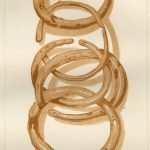
The antique specimens of this part of personal decoration, which are furnished by graves and tumuli, do not differ essentially in their mechanical execution, from similar productions among the remote tribes of this day. They are simple rings or bands of the metal, bent. There is no union of the bent ends by soldering. Oxidation has nearly destroyed them, in the mound specimens, which have come to our notice. In the specimens, (Plate 31,) exhumed from the western part of Virginia, at the Great Tumulus of Grave Creek Flats, a salt of copper, apparently a carbonate was formed upon the metal in such a manner as to protect it from further oxidation.
The use of this metal appears to have been very general by the American tribes at, and prior to, the era of the discovery; and the occurrence of the ornaments in graves and tumuli may be generally set down to that era.
The fur trade, which immediately succeeded the arrival of the first ships, soon replaced this rude ornament, by bands and bracelets of silver, or silvered copper and tin. The passion for silver, in all its manufactured forms, was early developed among the tribes. They regarded it as a nobler metal than gold. The name for gold, in all the languages known to us, is a modern descriptive phrase, signifying yellow metal. It would appear, that gold is not a product of the countries or islands from which the tribes originated.
